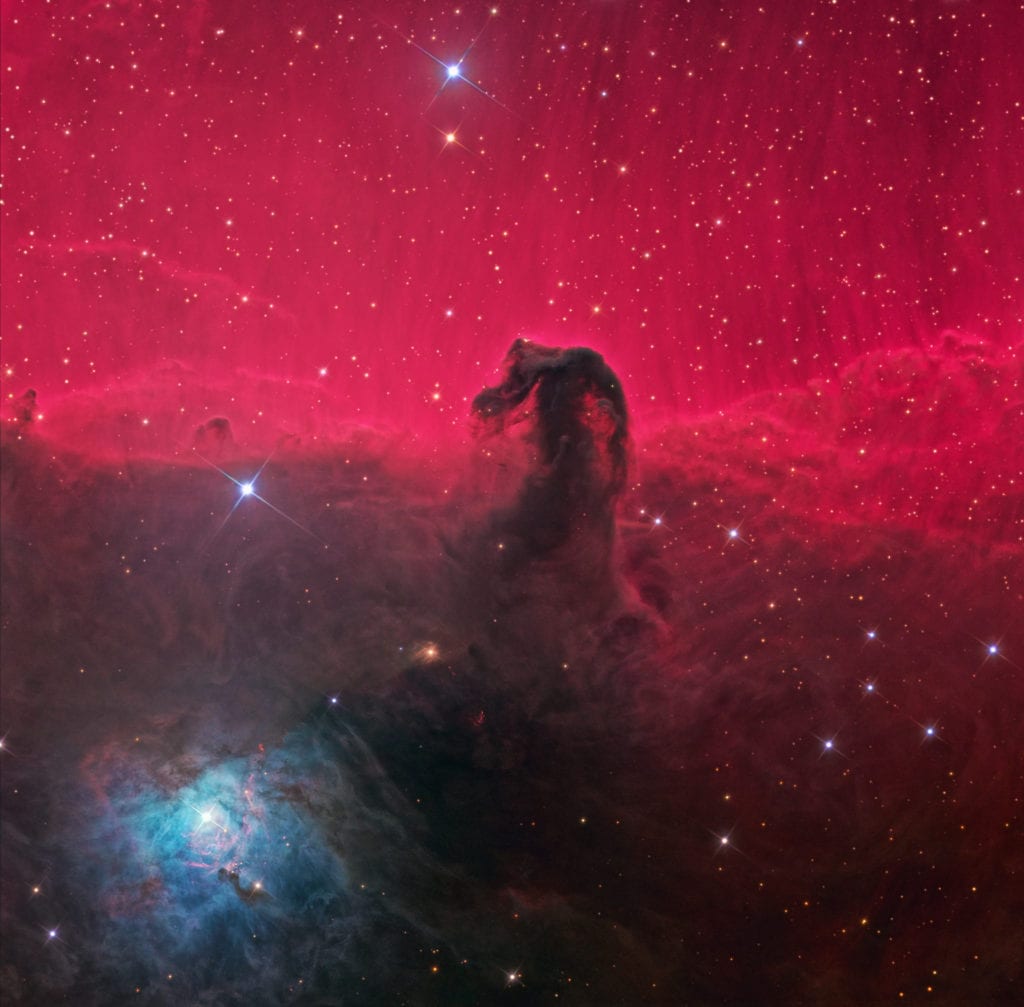The Horsehead Nebula is about 1400 light-years away from Earth, which means it takes 1400 years for light to travel from the nebula to our home planet. A light-year is a unit for measuring very long distances. One light-year is nearly six trillion miles, and it’s the most common unit of measure for distances of objects in outer space because most of them are extremely far away.
Nebulae are gigantic clouds formed out of gas and dust. Some interesting-looking nebulae are formed after a star dies in an explosion called a supernova. The Horsehead nebula has a dark color that features some deep red hues that are created by ionized hydrogen gas. Nebulae are also birthplaces for new stars that form out of the tremendous amounts of gaseous material that tend to condense into stars due to gravity.

The dark shape of the nebula is caused by thick dust that blocks the light of stars that lie beyond it. The head emerges from a large gas complex that is an active site for the formation of new, small stars. There are a number of bright spots at the base of the Horsehead nebula where new stars have been born.
History Of The Horsehead Nebula
The Horsehead nebula was officially discovered in 1888 by a Scottish astronomer named Williamina Flemming. She was at the Harvard College Observatory when she spotted the nebula, and she recorded its image on a photographic plate. The nebula was given the name Barnard 33 at that time, and it was described as a dark mass.
There was some controversy surrounding the discovery of the nebula. There were several different names given to it, and the credit for its discovery has been debated throughout the years. The first person to catalog the nebula was an American astronomer named Edward Emerson Barnard. He found it in 1913 using a telescope at the University of Chicago. Even further back in the 1800s, astronomer William Herschel reported seeing what he described as a hole in the heavens. Some astronomers believe this might have been the first sighting of the nebula because it occurred before its official discovery date of 1888.
It can be somewhat tricky to actually see the Horsehead nebula with your own eyes. It’s easy to find the belt in the constellation Orion, but you need to look for it on a dark clear night to make out the silhouette of the nebula in that region of the sky. If there is light pollution from nearby street lights or buildings, you might not be able to see the nebula.
How Big Is The Horsehead Nebula
It’s huge! Current estimates put it at 4 light years tall by 3 light years wide.
In miles its around 24 trillion miles tall by 18 trillion miles wide.
Summary of facts about the Horsehead Nebula
- The Horsehead nebula is about 1400 light years distant from Earth.
- It can be found just south of the belt in the constellation Orion.
- The Horsehead nebula is one of the most well-known astronomical objects because of its interesting shape.
- The nebula has a dark appearance because of dense dust and hydrogen gas that block other stars behind it.
- The iconic horse head image stands out because it is surrounded by the bright IC 434 nebula that is part of a larger nebula construct.
- The Horsehead nebula is about 4 light years tall and 3 light years across.
- In time, the nebula will be dispersed by ultraviolet light from stars in the vicinity.
- A 2001 poll of amateur astronomers revealed that it was their favorite celestial object.